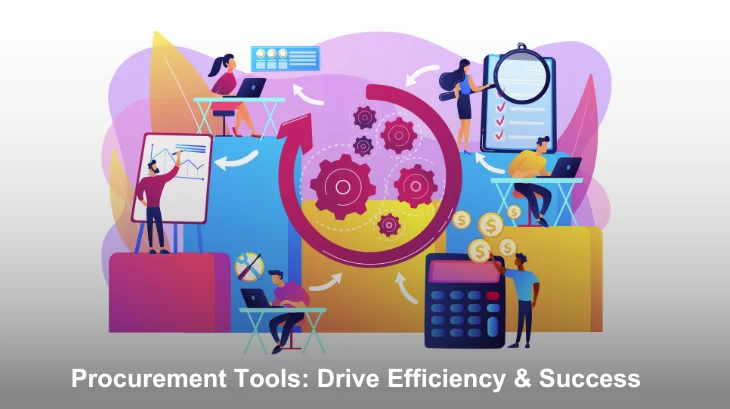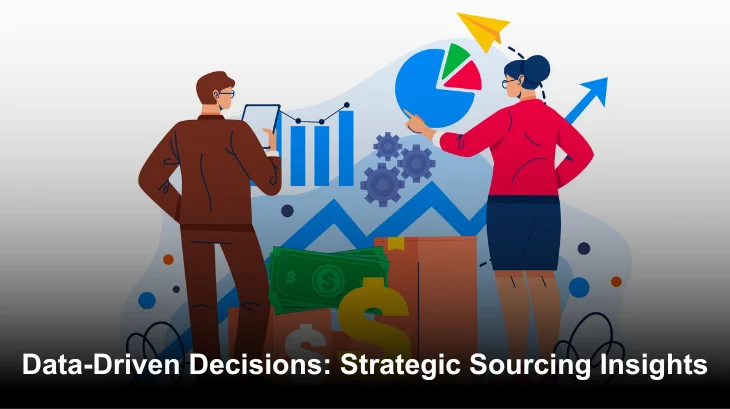
Have any questions Submit an Inquiry


In today’s dynamic business landscape, strategic sourcing stands tall as a linchpin, driving not only cost efficiencies but also fostering innovation and sustainable partnerships. As businesses increasingly recognize its value, strategic sourcing has metamorphosed from a transactional activity to a strategic function, intertwined with an organization’s broader vision and objectives.
However, as with any evolving domain, it brings forth its own set of challenges. Among the most nuanced is the task of establishing a solid baseline, especially when historical data—often the bedrock of procurement decisions—is absent. This lack of precedent can feel akin to navigating uncharted waters, where the familiar landmarks of past transactions and interactions are missing. Yet, it’s in these very challenges that opportunities arise, pushing businesses and procurement professionals to innovate, adapt, and forge new paths.
As we delve deeper into the intricacies of crafting a baseline without the guiding light of history, we’ll uncover the methodologies, the hurdles, and the transformative potential that lies therein.
In the vast orchestra of strategic sourcing, if each component were a musical instrument, the baseline would be the conductor’s baton, setting the rhythm and ensuring harmony. But what exactly is this baseline, and why does it command such pivotal importance?
At its core, a baseline represents a reference point, a snapshot of the current state against which future states can be compared. Within the realm of strategic sourcing, this translates to a comprehensive view of the existing costs associated with a particular set of goods or services. It captures not just the direct costs, but also the myriad indirect expenses, painting a holistic picture of the total cost of ownership (TCO).
TCO is a term often bandied about in procurement circles, but its true depth is realized only when viewed through the lens of a well-defined baseline. The baseline serves as a mirror, reflecting the myriad components that constitute the TCO – from direct procurement costs to indirect expenses like maintenance, operations, and even end-of-life costs. By offering a clear view of these components, the baseline becomes instrumental in identifying inefficiencies, uncovering hidden costs, and, most crucially, measuring the impact of any strategic changes made in the sourcing process.
Where the challenge of establishing a robust baseline grows, EmpoweringCPO’s methodologies rise to the occasion. Recognizing the critical role of baselines, our approach is rooted in a blend of precision, innovation, and deep industry insights. Rather than viewing the absence of historical data as a hindrance, we see it as an opportunity to innovate. By leveraging cutting-edge analytics, bespoke tools, and our rich repository of industry knowledge, we craft baselines that are not just accurate but also actionable. This meticulous approach ensures that our clients have a solid foundation upon which to build their strategic sourcing decisions, maximizing value and driving transformative results.
Strategic sourcing, in its essence, is a symphony of decision-making, driven by data, insights, and foresight. Yet, to truly gauge the efficacy of these decisions, there’s a need for a reference, a benchmark. This is where the baseline, often unsung, plays its pivotal role, acting as the keystone in the arch of strategic sourcing.
Imagine embarking on a transformative journey without knowing your starting point. How would you measure the distance traveled or the milestones achieved? In the world of procurement, the baseline serves this very purpose. By offering a clear snapshot of the existing costs and processes, it provides a tangible measure against which all future outcomes can be juxtaposed. Every dollar saved, every efficiency introduced, and every enhancement made becomes quantifiable. It’s this ability to tangibly measure savings and achievements that underscore the baseline’s criticality. With it, organizations can not only celebrate their successes but also refine their strategies, ensuring continuous improvement.
In the multifaceted realm of business, stakeholder trust is both a precious commodity and a foundational pillar. The baseline, with its empirical and transparent nature, plays a crucial role in building and cementing this trust. When stakeholders can visibly see the delta between the baseline and the new state, it fosters confidence in the strategic sourcing process and the decisions derived from it.
Moreover, a well-established baseline acts as a compelling narrative, showcasing the tangible benefits of strategic sourcing. It becomes a testament to its value, encouraging stakeholders to consider its application across newer, uncharted categories. By demonstrating proven results, the baseline paves the way for expanding the reach and impact of strategic sourcing, opening doors to new opportunities and greater value creation.
The creation of a robust baseline, much like crafting a masterpiece, is as intricate as it is essential. It’s a process that demands precision, insight and a deep understanding of the category in question. Yet, as with any endeavor of significance, it’s fraught with challenges that can test even the most seasoned procurement professionals.
On one end of the spectrum, certain categories are straightforward, with easily identifiable costs and clear-cut parameters. Crafting a baseline for these is akin to solving a well-defined puzzle, where each piece fits neatly into its designated spot. However, as we traverse to the other end, the complexity multiplies. Here, categories are multifaceted, characterized by a web of interrelated cost components, variable factors, and often, a lack of standardization. Creating a baseline for such categories is like assembling a jigsaw puzzle with pieces from multiple sets, demanding not just skill but also creativity and foresight.
In the intricate world of procurement, no two categories are identical, and neither are the scenarios surrounding them. This inherent variability necessitates a flexible approach to baseline methodologies, ensuring they resonate with the unique challenges and nuances of each category. Let’s explore how these methodologies can be aptly adapted to diverse scenarios.
Embarking on the journey of sourcing a new category is akin to navigating uncharted waters. Without the beacon of historical data, traditional baseline creation methodologies often fall short. However, innovative approaches can light the path:
The terrain here is familiar, but that doesn’t mean it’s devoid of challenges. Historical data might exist, but its completeness, relevance, and accuracy can vary:
At EmpoweringCPO, we recognize that baseline creation is not a one-size-fits-all endeavor. Our methodologies are tailored, drawing from a rich tapestry of industry experience, cutting-edge analytics, and deep-seated market insights. Whether it’s pioneering new categories or optimizing established ones, our approach is holistic, ensuring that baselines are not just numbers but strategic tools that drive value, efficiency, and transformative results.
In the intricate ballet of strategic sourcing, creating a robust baseline is a performance that demands finesse, precision, and deep-rooted expertise. EmpoweringCPO, with its rich legacy and innovative methodologies, has carved a niche, establishing itself as a maestro in this domain. Let’s delve into what sets us apart.
Our journey is best narrated through the stories of our successes. Each case study is a testament to our dedication, innovation, and unwavering commitment to excellence.
At the heart of EmpoweringCPO’s approach lies a triad that synergizes to deliver unparalleled results.
Decades of experience have not just honed our skills but have enriched our understanding of the myriad challenges and nuances of baseline creation. This vast reservoir of knowledge translates into solutions that are tailor-made, addressing the unique challenges, objectives, and intricacies of each client. We don’t believe in cookie-cutter solutions. Instead, we craft strategies that resonate with the specific needs and aspirations of each organization we partner with.
Navigating the labyrinth of strategic sourcing, the baseline emerges not as a mere metric but as the very compass guiding each decision, strategy, and negotiation. Its significance transcends numbers, embodying the essence of informed, strategic decision-making. An accurate baseline is not just a reflection of the present; it’s a beacon illuminating the path to future successes, shaping strategies, and driving transformative results.
At the crossroads of innovation and tradition, EmpoweringCPO stands as a vanguard, championing the cause of robust, actionable baselines. Our legacy, underpinned by a blend of expertise, innovation, and deep-seated market insights, is a testament to our commitment to excellence in this domain.
As we close this chapter, we invite you to embark on a journey with us, to explore the vast landscapes of strategic sourcing, and to experience firsthand the transformative power of an expertly crafted baseline. Dive deeper, discover more, and let’s shape the future of procurement together with EmpoweringCPO.
Email: Sales@EmpoweringCPO.com
Phone no: +91-987-956-4584
EmpoweringCPO is a team of experienced sourcing and procurement professionals with hands on experience of having worked with many fortune 500 companies. The company was founded in 2011 and since then has executed multiple strategic sourcing projects and have achieved average savings of 10-12% so far. In addition to Strategic Sourcing their other offerings are Spend Analysis, Procurement Intelligence, Procurement Analytics, Best Cost Country Sourcing, Procurement Outsourcing, Built Operate Transfer, Supplier Diversity, Sustainable Procurement, Tail Spend Management, Item Master Optimization, Collective Buying, Compliance Tracking and Managed Procurement Services.




Compliance management is very critical as otherwise the procurement organization may run into a scenario where there is a huge gap between realized savings and reported savings. Many procurement functions estimate large savings numbers when contracts are signed. They also invest significant time and effort in negotiating contracts for necessary goods and services, only to have a third or more of their purchasing dollars flow outside those deals. Some of the obvious fall-outs of non-compliance and maverick purchases are:
As compared to the current contract that was finalized after the sourcing process, the tool helps in tracking:
The objective of this tool is to ensure that the orders are placed only with the vendors that were shortlisted after the sourcing process and at the same price that was agreed upon and negotiated during and after the strategic sourcing process.